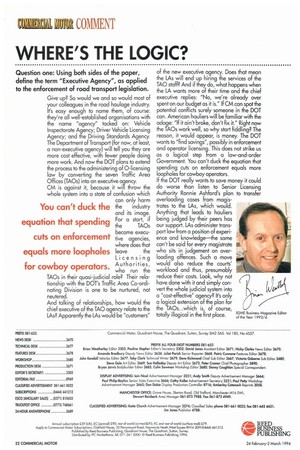WHERE'S THE LOGIC?
Page 24

If you've noticed an error in this article please click here to report it so we can fix it.
Question one: Using both sides of the paper, define the term "Executive Agency", as applied to the enforcement of road transport legislation.
Give up? So would we and so would most of your colleagues in the road haulage industry. It's easy enough to name them, of course: they're all well-established organisations with the name "agency" tacked on: Vehicle Inspectorate Agency; Driver Vehicle Licensing Agency; and the Driving Standards Agency. The Department of Transport (for now, at least, a non-executive agency) will tell you they are more cost effective, with fewer people doing more work. And now the DOT plans to extend the process to the administering of 0-licensing law by converting the seven Traffic Area Offices (TAOs) into an executive agency. CM is against it, because it will throw the whole system into a state of confusion which can only harm the industry and its image. For a start, if the TAOs become executive agencies, where does that leave the Licensing Authorities, who run the TAOs in their quasi-judicial role? Their relationship with the DOT's Traffic Area Co-ordinating Division is one to be nurtured, not neutered.
And talking of relationships, how would the chief executive of the TAO agency relate to the LAs? Apparently the LAs would be "customers" of the new executive agency. Does that mean the LAs will end up hiring the services of the TAO staff? And if they do, what happens when the LA wants more of their time and the chief executive replies: "No, we're already over spent on our budget as it is." If CM can spot the potential conflicts surely someone in the DOT can. American hauliers will be familiar with the adage: "If it ain't broke, don't fix it." Right now the TAOs work well, so why start fiddling? The reason, it would appear, is money. The DOT wants to "find savings , possibly in enforcement and operator licensing. This does not strike us as a logical step from a law-and-order Government. You can't duck the equation that spending cuts on enforcement equals more loopholes for cowboy operators. If the DOT really wants to save money it could do worse than listen to Senior Licensing Authority Ronnie Ashford's plan to transfer overloading cases from magistrates to the LAs, which would. Anything that leads to hauliers being judged by their peers has our support. LAs administer transport law from a position of experience and knowledge—the same can't be said for every magistrate who sits in judgement on overloading offences. Such a move would also reduce the courts' workload and thus, presumably reduce their costs. Look, why not have done with it and simply convert the whole judicial system into a "cost-effective" agency? It's only a logical extension of the plan for the TAOs.. .which is of course, totally illogical in the first place.




















































































